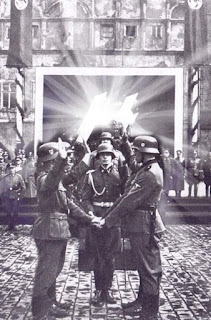IN THE RELIGIOUS history of the Aryan race in Europe the worship of trees has played an important part. Nothing could be more natural. For at the dawn of history Europe was covered with immense primaeval forests, in which the scattered clearings must have appeared like islets in an ocean of green. Down to the first century before our era the Hercynian forest stretched eastward from the Rhine for a distance at once vast and unknown; Germans whom Caesar questioned had travelled for two months through it without reaching the end. Four centuries later it was visited by the Emperor Julian, and the solitude, the gloom, the silence of the forest appear to have made a deep impression on his sensitive nature. He declared that he knew nothing like it in the Roman empire.

In our own country the wealds of Kent, Surrey, and Sussex are remnants of the great forest of Anderida, which once clothed the whole of the south-eastern portion of the island. Westward it seems to have stretched till it joined another forest that extended from Hampshire to Devon. In the reign of Henry II. the citizens of London still hunted the wild bull and the boar in the woods of Hampstead. Even under the later Plantagenets the royal forests were sixty-eight in number. In the forest of Arden it was said that down to modern times a squirrel might leap from tree to tree for nearly the whole length of Warwickshire. The excavation of ancient pile-villages in the valley of the Po has shown that long before the rise and probably the foundation of Rome the north of Italy was covered with dense woods of elms, chestnuts, and especially of oaks. Archaeology is here confirmed by history; for classical writers contain many references to Italian forests which have now disappeared. As late as the fourth century before our era Rome was divided from central Etruria by the dreaded Ciminian forest, which Livy compares to the woods of Germany. No merchant, if we may trust the Roman historian, had ever penetrated its pathless solitudes; and it was deemed a most daring feat when a Roman general, after sending two scouts to explore its intricacies, led his army into the forest and, making his way to a ridge of the wooded mountains, looked down on the rich Etrurian fields spread out below.

In Greece beautiful woods of pine, oak, and other trees still linger on the slopes of the high Arcadian mountains, still adorn with their verdure the deep gorge through which the Ladon hurries to join the sacred Alpheus, and were still, down to a few years ago, mirrored in the dark blue waters of the lonely lake of Pheneus; but they are mere fragments of the forests which clothed great tracts in antiquity, and which at a more remote epoch may have spanned the Greek peninsula from sea to sea.

From an examination of the Teutonic words for “temple” Grimm has made it probable that amongst the Germans the oldest sanctuaries were natural woods. However that may be, tree-worship is well attested for all the great European families of the Aryan stock. Amongst the Celts the oak-worship of the Druids is familiar to every one, and their old word for sanctuary seems to be identical in origin and meaning with the Latin nemus, a grove or woodland glade, which still survives in the name of Nemi. Sacred groves were common among the ancient Germans, and tree-worship is hardly extinct amongst their descendants at the present day. How serious that worship was in former times may be gathered from the ferocious penalty appointed by the old German laws for such as dared to peel the bark of a standing tree. The culprit’s navel was to be cut out and nailed to the part of the tree which he had peeled, and he was to be driven round and round the tree till all his guts were wound about its trunk. The intention of the punishment clearly was to replace the dead bark by a living substitute taken from the culprit; it was a life for a life, the life of a man for the life of a tree. At Upsala, the old religious capital of Sweden, there was a sacred grove in which every tree was regarded as divine.

The heathen Slavs worshipped trees ad groves. The Lithuanians were not converted to Christianity till towards the close of the fourteenth century, and amongst them at the date of their conversion the worship of trees was prominent. Some of them revered remarkable oaks and other great shady trees, from which they received oracular responses. Some maintained holy groves about their villages or houses, where even to break a twig would have been a sin. They thought that he who cut a bough in such a grove either died suddenly or was crippled in one of his limbs.

Proofs of the prevalence of tree-worship in ancient Greece and Italy are abundant. In the sanctuary of Aesculapius at Cos, for example, it was forbidden to cut down the cypress-trees under a penalty of a thousand drachms. But nowhere, perhaps, in the ancient world was this antique form of religion better preserved than in the heart of the great metropolis itself. In the Forum, the busy centre of Roman life, the sacred fig-tree of Romulus was worshipped down to the days of the empire, and the withering of its trunk was enough to spread consternation through the city. Again, on the slope of the Palatine Hill grew a cornel-tree which was esteemed one of the most sacred objects in Rome. Whenever the tree appeared to a passer-by to be drooping, he set up a hue and cry which was echoed by the people in the street, and soon a crowd might be seen running helter-skelter from all sides with buckets of water, as if (says Plutarch) they were hastening to put out a fire.

Taken from:
Sir James George Frazer - The Golden Bough (1922)
Chapter: The Worship of Trees



















































